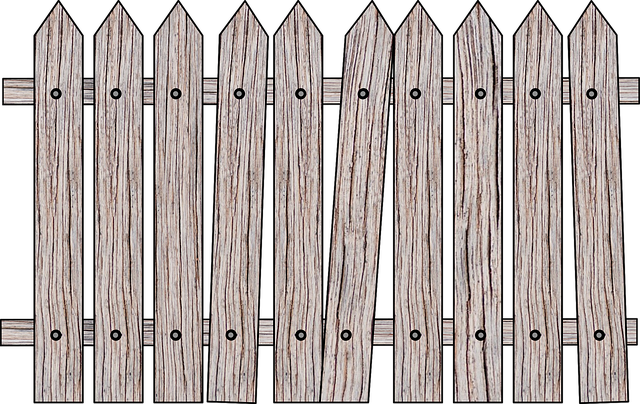Introduction:
Coastal areas present unique challenges for fencing due to relentless wind, salt air, and frequent moisture. This article explores durable wooden fencing as a robust solution for these harsh environments. We delve into the intricacies of understanding coastal fencing challenges, highlighting the benefits of choosing the right wood species for enhanced longevity. Additionally, we offer practical installation and maintenance tips, ensuring your fence not only withstands but also enhances the coastal aesthetic.
- Understanding Coastal Fencing Challenges
- Benefits of Durable Wooden Fencing
- Choosing the Right Wood Species
- Installation and Maintenance Tips
- Enhancing Coastal Aesthetics with Wooden Fences
Understanding Coastal Fencing Challenges
Coastal areas present unique challenges for fencing due to their harsh, often unpredictable environments. Saltwater, strong winds, and frequent storms can significantly impact traditional fencing materials, leading to frequent repairs or replacements. The key to successful coastal fencing lies in selecting durable materials that can withstand these elements while also blending aesthetically with the surrounding landscape.
Wooden fences, for instance, must be treated with special coatings to protect against moisture and corrosion. Choosing the right type of wood, such as cedar or treated pine, is essential for long-term durability. Additionally, proper installation techniques, including elevated posts and adequate spacing, help mitigate damage caused by coastal conditions, ensuring a robust and visually appealing fence that can endure the test of time.
Benefits of Durable Wooden Fencing
Durable wooden fencing offers numerous advantages for coastal areas, providing both functional and aesthetic solutions. One of its key benefits is longevity; treated and maintained properly, wood can withstand harsh coastal conditions, including salt spray and high humidity, making it a sustainable option for long-term use. This durability not only reduces the need for frequent replacements but also minimizes maintenance costs over time.
Additionally, wooden fencing can enhance the natural beauty of coastal landscapes without compromising strength or security. Its versatility allows for creative designs, from traditional styles to modern, minimalist aesthetics. Furthermore, wood is an eco-friendly material, as it is renewable and can be sourced responsibly, contributing to a more sustainable environment in coastal communities.
Choosing the Right Wood Species
When selecting wood for coastal fencing, understanding the local climate and environmental conditions is key. Saltwater exposure, wind, and moisture can rapidly deteriorate regular wooden fences. Choosing the right wood species that possesses natural resistance to decay and elements is essential. Hardwoods like cedar or redwood are popular choices due to their inherent resilience. These woods have a high oil content, which acts as a natural barrier against water absorption and fungal growth.
Considered durable and low-maintenance, cedar fences can withstand coastal conditions for several years. Redwood, too, offers excellent resistance to rot and insects, making it an ideal option for areas prone to salty air and high winds. Each species has unique characteristics, so evaluating your specific needs—be it privacy, aesthetic appeal, or budget—will help guide your decision in selecting the best wood type for your coastal fencing project.
Installation and Maintenance Tips
When installing wooden fencing in coastal areas, it’s crucial to ensure proper drainage to prevent water damage. Digging a slightly sloped trench and fitting the fence posts with metal plates or feet can help divert water away from the wood. Use high-quality, pressure-treated lumber that’s resistant to rot and decay for added durability. Regular cleaning with mild soap and water is essential to remove salt deposits and maintain the finish.
For maintenance, inspect your fence at least twice a year, looking for any signs of damage or rot. Repaint or restain as needed, using products specifically designed for exterior use. Consider sealing the wood annually to protect it from harsh coastal conditions. Promptly repair or replace any damaged sections to maintain the overall integrity and aesthetic appeal of your durable wooden fencing.
Enhancing Coastal Aesthetics with Wooden Fences
Wooden fences have long been a beloved feature in many coastal communities, not just for their functional purpose but also for their ability to enhance the natural beauty of the region. The warmth and texture of wood complement the ocean views and sandy shores, creating a harmonious blend that is uniquely coastal. With the right design and maintenance, these fences can become iconic landmarks, adding character and charm to any seaside property or public space.
Using durable wooden fencing materials specifically designed for coastal environments ensures both longevity and aesthetic appeal. Treated to resist rot, mold, and insect damage, these fences can withstand the harshest conditions, from salty sea air to pounding rain. This way, they not only contribute to the visual appeal of the coastline but also provide a reliable solution for property owners and local governments seeking to preserve and enhance their coastal landscapes.
